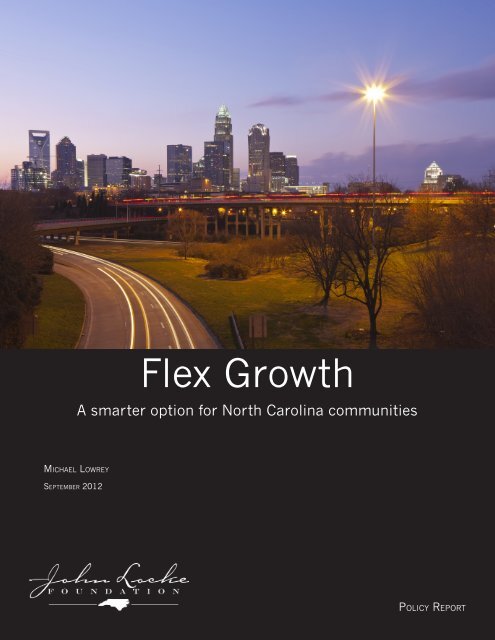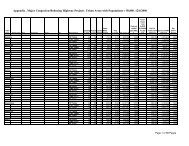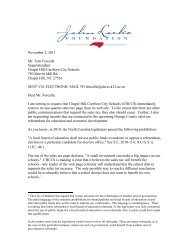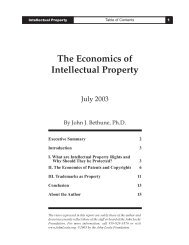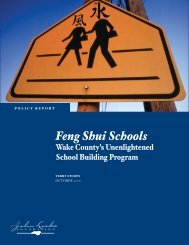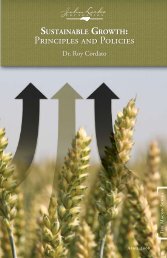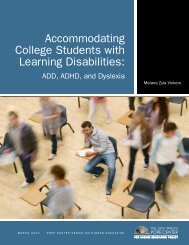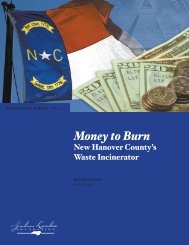Flex Growth - John Locke Foundation
Flex Growth - John Locke Foundation
Flex Growth - John Locke Foundation
Create successful ePaper yourself
Turn your PDF publications into a flip-book with our unique Google optimized e-Paper software.
<strong>Flex</strong> <strong>Growth</strong><br />
A smarter option for North Carolina communities<br />
Michael Lowrey<br />
September 2012<br />
Policy Report
<strong>Flex</strong> <strong>Growth</strong><br />
A smarter option for North Carolina communities<br />
Michael Lowrey<br />
Contents<br />
3 Executive Summary<br />
4 What is Smart <strong>Growth</strong>?<br />
4 Smart <strong>Growth</strong>’s Failings<br />
6 <strong>Flex</strong> <strong>Growth</strong>: An Agenda for the Future<br />
10 Conclusions<br />
12 End Notes<br />
14 About the Author<br />
15 About the <strong>John</strong> <strong>Locke</strong> <strong>Foundation</strong><br />
The views expressed in this report are solely those of the author and do not necessarily reflect those of the staff or<br />
board of the <strong>John</strong> <strong>Locke</strong> <strong>Foundation</strong>. For more information, call 919-828-3876 or visit www.<strong>John</strong><strong>Locke</strong>.org.<br />
©2012 by the <strong>John</strong> <strong>Locke</strong> <strong>Foundation</strong>.
Executive Summary<br />
FLEX GROWTH<br />
3<br />
In recent years, an increasing number of local governments<br />
across the nation and across North Carolina<br />
have adopted “Smart <strong>Growth</strong>” policies. While the<br />
specific policies differ by community, the emphasis is<br />
invariably upon restricting the physical size of urban<br />
areas, imposing denser development standards in areas<br />
where development is allowed, and reducing funding<br />
for roads while spending heavily on transit in general<br />
and rail-based transit in particular.<br />
Such policies are both misguided and ineffective<br />
— misguided, in that they do not create communities<br />
in which most people really want to live and ineffective<br />
in that the cost of “sprawl” and the benefits of Smart<br />
<strong>Growth</strong> are both overstated.<br />
Specifically, Smart <strong>Growth</strong> misdefines efficiency<br />
to mean simply maximizing production of a particular<br />
product (typically housing) while using the minimum<br />
of a particular resource (land). This definition is in conflict<br />
with basic economic theory.<br />
A number of economic studies, meanwhile, have<br />
shown that Smart <strong>Growth</strong> policies are not less costly<br />
than what its proponents dismiss as “sprawl.” Smart<br />
<strong>Growth</strong> does, however, impose additional costs upon<br />
society which make economic growth less likely.<br />
Instead of focusing on the past, North Carolina<br />
should look to the future and adopt a flexible growth<br />
agenda — <strong>Flex</strong> <strong>Growth</strong>. <strong>Flex</strong> <strong>Growth</strong> is a market-based<br />
system of principles for government land use and development<br />
policy, especially at the state and local government<br />
levels, based upon the idea that people — and<br />
not government bureaucrats and planners — know<br />
what is best for themselves.<br />
The following nine recommendations should guide<br />
policymakers when they consider various responses to<br />
growth and development:<br />
1. Let growth pay for itself — Local governments<br />
should adopt marginal cost pricing for public services<br />
to avoid distorting land development decisions<br />
and enable growth to pay for itself.<br />
2. But without impact fees for schools — The concept<br />
of user fees — whether they are called “impact<br />
fees,” “real estate transfer fees,” or an “adequate<br />
public facilities ordinance” — should not<br />
extend to funding public school construction.<br />
3. Reform zoning — Local zoning codes should be<br />
changed in several ways to take advantage of market<br />
incentives to reflect the true costs of development.<br />
Public policy should also afford communities<br />
the flexibility to adapt to the new demands and<br />
practical requirements they face.<br />
4. Strengthen private property rights — The value<br />
of land is based upon its market potential, not its<br />
current use. For the full market potential of land<br />
to be realized, it must be available for sale, but to<br />
be available for sale, a clear set of private property<br />
rights must be in place.<br />
5. Let the market provide open space — Each individual<br />
is willing to pay a different amount for open<br />
space, be it a private back yard or communal park<br />
land. The market is best suited to meet people’s<br />
actual demands rather than government mandates<br />
to provide a set communal open space.<br />
6. Pursue economic policy neutrality — Policymakers<br />
should aim for strict neutrality in their economic<br />
development and industrial recruitment efforts.<br />
This includes local governments staying out<br />
of the utility and broadband businesses.<br />
7. Avoid TIFs — Local governments should avoid<br />
tax increment financing (TIFs) to borrow money<br />
for economic development projects.<br />
8. Ensure an adequate highway system — Transportation<br />
funding is finite. It follows then that the<br />
state and its localities should make the best possible<br />
use of this scarce resource by funding the projects<br />
that give the greatest return on investment.<br />
9. Fund transit intelligently — The same resource<br />
usage considerations that drive our approach to<br />
roads should also drive our approach to transit:<br />
aim to fund only those projects that provide the<br />
most bang for the buck.<br />
P O L I C Y R E P O R T
4<br />
F L E X G R O W T H<br />
Smart growth. Managed growth. These terms seem<br />
omnipresent in all facets of public policy discussions<br />
today — about taxes, schools, zoning. Proponents wax<br />
eloquently of “quality-of-life issues,” “sustainable”<br />
growth (whatever that means), lots of green space,<br />
small lots, mixed-use development, environmental conservation,<br />
mass transit, urban high-rises, high population<br />
density, “walkable” communities, “traffic calming”<br />
devices (narrow streets, barriers between walkways and<br />
roadways, etc. designed to slow down traffic), and the<br />
like. But many of these terms are contradictory, much<br />
like the aims of the various groups within the coalition<br />
supporting Smart <strong>Growth</strong>.<br />
In any case, Smart <strong>Growth</strong>, with its rigid emphasis<br />
on limiting the size of urban areas via government<br />
restrictions, represents a flawed model. It ignores consumer<br />
preferences. Smart <strong>Growth</strong> also drives up the cost<br />
of land, thus increasing the cost of living, particularly<br />
hurting the poor. It also increases government power<br />
and bureaucratic discretion.<br />
What North Carolina needs instead is a flexible approach<br />
to growth.<br />
I. What is Smart <strong>Growth</strong>?<br />
Smart <strong>Growth</strong> is a theory of urban development that<br />
seeks to more highly concentrate urban growth through<br />
increased government regulation of development, housing,<br />
and transportation.<br />
In an entry obviously written by a proponent of the<br />
policy, Wikipedia lists 10 objectives associated with<br />
Smart <strong>Growth</strong> 1 :<br />
1. Mix land uses.<br />
2. Take advantage of compact building design.<br />
3. Create a range of housing opportunities and<br />
choices.<br />
4. Create walkable neighborhoods.<br />
5. Foster distinctive, attractive communities with a<br />
strong sense of place.<br />
6. Preserve open space, farmland, natural beauty,<br />
and critical environmental areas.<br />
7. Strengthen and direct development towards existing<br />
communities.<br />
8. Provide a variety of transportation choices.<br />
9. Make development decisions predictable, fair,<br />
and cost effective.<br />
10. Encourage community and stakeholder collaboration<br />
in development decisions.<br />
As applied, Smart <strong>Growth</strong> policies typically aim to<br />
restrict, or even eliminate, development in new areas,<br />
preventing what Smart <strong>Growth</strong> advocates derisively label<br />
“sprawl,” which they claim is inefficient and ugly.<br />
At the same time, Smart <strong>Growth</strong> policies encourage<br />
public transit, particularly pricey new rail transit lines,<br />
at the expense of roads. These new transit lines, which<br />
by their nature serve a limited geographic area, are to<br />
act as magnets for redevelopment, including new medium-rise<br />
condominium developments.<br />
A second, newer concept that has helped drive the<br />
push toward Smart <strong>Growth</strong> policies in certain communities<br />
is Richard Florida’s controversial theory of the<br />
“creative class.” 2 Florida argues that knowledge workers,<br />
intellectuals, and artists of various sorts will be the<br />
leading force for economic growth in coming years.<br />
The places that can attract the creative class will prosper,<br />
he says, while those places that can not attract these<br />
individuals will stagnate. 3<br />
Local government officials often take this theory to<br />
mean that communities are essentially in a bidding war<br />
for the creative class — that they must provide more<br />
of the types of things the creative class is said to value<br />
or risk the economic consequences. And as it happens,<br />
the creative class is said to value most of the key Smart<br />
<strong>Growth</strong> objectives.<br />
II. Smart <strong>Growth</strong>’s Failings<br />
Despite being all the rage for planners and environmentalists,<br />
Smart <strong>Growth</strong> represents a fundamentally<br />
flawed approach. It does not represent how most people<br />
truly want to live. It transforms transportation policy<br />
into a form of economic development policy. Smart<br />
<strong>Growth</strong> also is based upon economic misconceptions<br />
and embraces an elitist sense of aesthetics.<br />
J O H N L O C K E F O U N D A T I O N
FLEX GROWTH<br />
5<br />
A. Most Americans prefer the suburbs<br />
At its most basic level, Smart <strong>Growth</strong> is a backward-looking<br />
economic development model. It looks<br />
back a century to the densely built, rail transit dependent<br />
cities of the late 19th and early 20th centuries as<br />
its inspiration. Smart <strong>Growth</strong> advocates assume that<br />
this earlier vision is how most Americans want to live,<br />
that we as a people have simply been deluded by automobile<br />
manufacturers and real estate agents into giving<br />
up apartments and condos in high-rise buildings along<br />
subways and light-rail lines in favor of detached houses<br />
on quarter-acre lots out in the suburbs. In this, Smart<br />
<strong>Growth</strong> advocates are wrong.<br />
To be sure, a percentage of Americans do want to<br />
live in densely-built urban areas. The number, though,<br />
is relatively small and constant. 4 Over the past decade,<br />
nearly 80 percent of housing built in the country’s 51<br />
metropolitan areas with populations of over 1,000,000<br />
were single-family, detached houses. 5<br />
It is often argued that Millennials — those born between<br />
1982 and 2003 — are different. There is scant evidence<br />
to support this conclusion. A large plurality (43<br />
percent) of Millennials say that suburbs are an “ideal<br />
place to live.” 6 And many of those who currently enjoy<br />
an urban lifestyle will move to the suburbs to settle<br />
down and have kids — or to settle down and have their<br />
parents move in after they retire. Or both, as the number<br />
of multi-generational households grows. 7<br />
B. Smart <strong>Growth</strong> misdefines efficiency…<br />
One of the more common arguments against<br />
“sprawl” is that it is somehow “inefficient.” Of course,<br />
the key is how one defines the concept of “efficiency.”<br />
The typical environmentalist definition regards lowdensity<br />
suburban housing as inefficient because relatively<br />
few people live on an acre of land. A productive<br />
resource, land, is not used as intensely as it could be;<br />
with denser development, more families could live in<br />
the same amount of space.<br />
While this may seem a logical definition of “efficiency,”<br />
it is in fact far off the mark. Economic theory<br />
tells us that efficiency — which involves the best allocation<br />
of resources within society — is associated with<br />
people acting to maximize their personal happiness and<br />
involves the benefits of something balancing with the<br />
costs of that product or item.<br />
Unfortunately, the environmentalist definition of<br />
efficiency has nothing to do with making people happy,<br />
but everything to do with maximizing production<br />
with the minimum of a particular resource. The two approaches<br />
are fundamentally different.<br />
C. …and is shown not to cost less<br />
A more sophisticated version of this inefficiency argument<br />
contends that sprawl is undesirable as it imposes<br />
additional costs upon society as compared to denser<br />
forms of development (i.e. Smart <strong>Growth</strong>).<br />
In general, it is asserted by Smart <strong>Growth</strong> advocates<br />
that lower local government costs are associated with<br />
higher population densities, lower rates of population<br />
growth, and older municipalities. Whether this is true<br />
or not is an empirical question that Wendell Cox and<br />
Joshua Utt addressed in a 2004 paper for the Heritage<br />
<strong>Foundation</strong>. 8 Their analysis found “no practically significant<br />
difference in expenditures per capita between<br />
the more sprawling and less sprawling communities.” 9<br />
What the two researchers did find was that differences<br />
in employee compensation explained most of the<br />
variation in municipal expenditures. As Cox and Utt<br />
noted, “It seems much more likely that the differences<br />
in municipal expenditures per capita are the result of<br />
political, rather than economic, factors — especially the<br />
influence of special interests.” 10<br />
Writing in the Journal of the American Planning Association,<br />
four British researchers reached similar conclusions<br />
about the impact of Smart <strong>Growth</strong> in a 2012<br />
paper. 11 Marcial H. Echenique, Anthony J. Hargreaves,<br />
Gordon Mitchell, and Anil Namdeo found that Smart<br />
<strong>Growth</strong> was not inherently preferable to less dense land<br />
use patterns based on an analysis of the experiences of<br />
three British areas. The authors concluded that “Smart<br />
growth principles should not unquestioningly promote<br />
increasing levels of compaction on the basis of reducing<br />
energy consumption without also considering its potential<br />
negative consequences. In many cases, the potential<br />
socioeconomic consequences of less housing choice,<br />
P O L I C Y R E P O R T
6<br />
F L E X G R O W T H<br />
crowding, and congestion may outweigh its very modest<br />
CO2 reduction benefits.” 12<br />
In the alternative, it has been argued that sprawl is<br />
inefficient in that it creates transportation externalities.<br />
A new paper by two Florida State University economists<br />
examines the issue and finds no relationship between<br />
degree of sprawl and commute times, automobile ownership,<br />
miles driven, fatal auto accidents, air pollution,<br />
or highway expenditures. 13 Indeed, a strong argument<br />
can be made that, all other things being equal, higher<br />
population density, more intense traffic congestion, and<br />
higher concentrations of air pollution all go together. 14<br />
D. Smart <strong>Growth</strong> reduces economic growth<br />
As the events of the Great Recession make abundantly<br />
clear, government cannot magically generate<br />
economic growth. Adopting Smart <strong>Growth</strong> does not<br />
change that. Indeed, the costs associated with Smart<br />
<strong>Growth</strong> impose significant burdens that make economic<br />
growth less likely. Smart <strong>Growth</strong> uses scarce public<br />
resources in an unwise manner that does not produce<br />
the greatest possible return. It also makes housing more<br />
expensive by limiting the amount of land available for<br />
development, thus increasing the local cost of living. 15<br />
While the focus in recent years has usually been on<br />
generating (creative class) jobs, Smart <strong>Growth</strong> has also<br />
been used as a rationalization for policies to explicitly<br />
restrict in-migration to communities. This typically involves<br />
limiting the amount of land available for development<br />
through urban growth borders, requirements for<br />
open space, and/or a call for “preservation” in order to<br />
establish “sustainable” growth patterns.<br />
Ironically, such policies often work in favor of those<br />
who moved to a community for exactly the same reasons<br />
that later arrivals are coming. These elitist schemes also<br />
necessarily limit opportunities for existing residents.<br />
III. <strong>Flex</strong> <strong>Growth</strong>: An Agenda for the Future<br />
Instead of focusing on the past, North Carolina<br />
should look to the future and adopt a flexible growth<br />
agenda — <strong>Flex</strong> <strong>Growth</strong>. <strong>Flex</strong> <strong>Growth</strong> is a market-based<br />
system of principles for government land use and development<br />
policy, especially at the state and local government<br />
levels, based upon the idea that people — and not<br />
government bureaucrats and planners — know what is<br />
for best for themselves. <strong>Flex</strong> <strong>Growth</strong> is built upon basic<br />
economic principles, and recognizes the importance of<br />
free markets.<br />
First and foremost, <strong>Flex</strong> <strong>Growth</strong> requires that, with<br />
the exception of schools, growth pay for itself, but nothing<br />
beyond that. It also seeks to strengthen property<br />
rights and reform zoning. <strong>Flex</strong> <strong>Growth</strong> calls for keeping<br />
government from picking winners and losers and engaging<br />
in questionable economic development schemes.<br />
<strong>Flex</strong> <strong>Growth</strong> also recognizes that transportation<br />
dollars are a scarce resource and should be treated as<br />
such. Too often transportation projects, especially transit<br />
lines, are funded not because they represent the most<br />
efficient way of improving mobility within society, but<br />
for political reasons. <strong>Flex</strong> <strong>Growth</strong> seeks instead to put<br />
transit dollars to their best possible use, to get as much<br />
bang-for-the-buck as possible.<br />
Nine specific recommendations for <strong>Flex</strong> <strong>Growth</strong><br />
are:<br />
1. Let growth pay for itself<br />
Local governments should adopt marginal cost<br />
pricing for public infrastructure services. This would<br />
help avoid the distortion of land development decisions<br />
and would enable growth to pay for itself. For example,<br />
utilities operated by municipalities should collect the<br />
full “cost-of-doing business,” including capital costs,<br />
for on-site services. The true cost of connecting a specific<br />
new development to water mains should be the<br />
basis for a hookup fee, rather than the average cost. In<br />
other words, the price will reflect such considerations<br />
as existing water capacity, labor markets, and expected<br />
future demand. The principle should be that the user, as<br />
much as possible, should bear the costs of services. In<br />
the case of water and sewer hookups, street access, and<br />
garbage collection, most communities are already using<br />
devices such as user charges or fees to impose the cost<br />
of new development on those (such as future homebuyers)<br />
who will benefit.<br />
The economic analysis to determine costs of providing<br />
services, and by extension whether to charge im-<br />
J O H N L O C K E F O U N D A T I O N
FLEX GROWTH<br />
7<br />
pact fees either directly or through an Adequate Public<br />
Facilities Ordinance, should be done by qualified uninterested<br />
parties. Too often, localities rely upon consultants<br />
who are selected exactly because they are likely to<br />
provide reports to justify higher impact fees. 16<br />
2. But without impact fees for schools<br />
Where many local leaders have gone awry in recent<br />
years is treating public education as one of the services<br />
to which the principle of user fees or impact fees can<br />
and should apply. This is mistaken. At least two important<br />
characteristics of public schools distinguish them<br />
from public utilities:<br />
Public education is an entitlement. Or so, at least,<br />
the N.C. Supreme Court has ruled. Unlike streets or<br />
sewer service, which government provides because alternative<br />
provision is believed to be either inefficient or<br />
impossible, government funding of public education is<br />
justified because of the need for a self-governing republic<br />
to have an educated citizenry. In North Carolina, the<br />
primary responsibility for funding public school operations<br />
lies with the state, with local governments funding<br />
most of the capital needs.<br />
The needed nexus between development and impact<br />
is lacking. Unlike street or sewer use, school use<br />
bears no direct relationship to the construction of a new<br />
home. For example, the purchasers of that home might<br />
already live in the county, with a child already in the<br />
public schools in that school district. Moving from one<br />
house to another does not increase the number of children<br />
in the school system. Similarly, a purchaser from<br />
outside the county may have no children or choose to<br />
send them to a private or charter school or home school.<br />
While there may be a general, county-wide correlation<br />
between population growth, commercial or residential<br />
development, and school enrollment, the correlation<br />
breaks down at the house or neighborhood level.<br />
For these reasons, a system that charges “impact<br />
fees” or “real estate transfer fees” in an attempt to collect<br />
revenue for new schools is inequitable and inefficient.<br />
Indeed, given the unique way that public education is<br />
consumed — disproportionately by relatively younger<br />
families with little history of property tax payment — it<br />
is simply impossible for any “user” to prepay, through<br />
property or other taxes, the cost of housing a student<br />
in a public school. Both newcomers and longtime residents<br />
therefore are subsidized by other taxpayers when<br />
their children attend public schools. Both groups pay<br />
this subsidy back through property taxes over time. The<br />
same is not true for streets, water service, or sewer service,<br />
which is paid for by every resident of a new development<br />
through immediate, monthly charges based<br />
on usage (including gas taxes) and initial hookup fees.<br />
3. Reform zoning<br />
Originally, land-use regulations were intended to<br />
control for “nuisances,” or negative effects on neighbors,<br />
such as congestion, noise, and loss of open space.<br />
However, zoning actually diminishes the importance of<br />
these nuisances, also called “externalities,” in land development.<br />
With Smart <strong>Growth</strong>, zoning often becomes<br />
focused on “preservation” or restricting in-migration.<br />
Instead, public policy should afford communities<br />
the ultimate in flexibility to adapt and change to the new<br />
demands and practical requirements facing them as well<br />
as to mitigate specific nuisances or harms. Communities<br />
can evolve if state and local land policies do the<br />
following: 17<br />
• Focus on the actual impacts of development, not<br />
on land uses per se;<br />
• Restrict detailed planning to public infrastructure<br />
investments; and<br />
• Abandon comprehensive zoning, which creates<br />
a political environment impeding change and<br />
subordinating property rights to political pull.<br />
The model in limiting restrictive land-use policies is<br />
Houston, which not coincidently also enjoys a low cost<br />
of living — particularly housing prices — for such an<br />
economically dynamic city. 18<br />
A property rights based approach allows a property<br />
owner to lodge a complaint against a particular land use<br />
by showing that it has a direct, demonstrable impact on<br />
other property owners. A nuisance-creating owner then<br />
compensates other property owners for the effect of the<br />
nuisance. But unsubstantiated complaints are not allowed<br />
to scuttle developments from which many unrep-<br />
P O L I C Y R E P O R T
8<br />
F L E X G R O W T H<br />
resented people, such as prospective homebuyers, will<br />
benefit.<br />
Real estate developers already make economical<br />
choices when the prices of public services reflect the<br />
full cost of providing them to a new development. And<br />
developers are already responding to consumers who<br />
want the aesthetic benefits of open space but not the<br />
hard work of maintaining a large yard. Local zoning<br />
codes, however, are often at odds with such responses<br />
because they use antiquated design standards and impose<br />
costly approval processes that allow groups or individuals<br />
to protest a development for almost any reason.<br />
Local codes should be changed to take advantage<br />
of markets in the following ways:<br />
• Accommodate mixed uses explicitly in the zoning<br />
code to minimize the need for continuous<br />
amendment;<br />
• Use performance-zoning criteria such as open<br />
space or landscaping provisions to allow projects<br />
to qualify for quick administrative approval<br />
once they meet certain design thresholds; and<br />
• Establish a presumption in favor of development-project<br />
approval in the zoning process.<br />
4. Strengthen private property rights<br />
A smoothly functioning real estate market requires<br />
a well-defined and enforceable system of property<br />
rights. Unfortunately, property right protections are not<br />
as strong as they could be in North Carolina.<br />
The value of land is based upon its market potential,<br />
not its current use. In order to obtain the full market<br />
potential of land, it must be available for sale. As homeowners<br />
in places like Cary can attest, it is a hollow form<br />
of property rights to allow land ownership but restrict,<br />
often arbitrarily, when it can be developed. The result is<br />
lost value — and in the case of families whose land is<br />
intended as retirement savings or inheritance, economic<br />
turmoil.<br />
A related concern is who determines when a property<br />
is developed and for whose benefit. In 2005, the U.S.<br />
Supreme Court held in Kelo v. City of New London that<br />
the U.S. Constitution does not prevent the government<br />
from taking private property through eminent domain<br />
to transfer to another private party for its use. Typically<br />
such a transaction happens as part of an economic development<br />
proposal.<br />
North Carolina law does prohibit such use of eminent<br />
domain, but this is a weak protection, as the General<br />
Assembly may at any time alter state law. This is<br />
especially an issue as major incentive deals often require<br />
enabling legislation from the General Assembly.<br />
A stronger safeguard would be to place a prohibition<br />
on Kelo-type uses of eminent domain in the state Constitution.<br />
North Carolina is the only state that does not<br />
currently address eminent domain in its constitution. 19<br />
5. Let the market provide open space<br />
At its core, Smart <strong>Growth</strong> seeks to make open space<br />
in urban areas communal. It does this through aiming<br />
to restrict traditional home homeownership, with its associated<br />
quarter-acre lot, while seeking to impose requirements<br />
that developers provide a fixed percentage<br />
of open space in their developments. This approach is<br />
misguided.<br />
Each individual places a different value upon communal<br />
open space, as opposed to the privately owned<br />
open space called a back yard, and is willing to spend<br />
differing amounts to be around each. Developers recognize<br />
this and respond to these desires accordingly. For<br />
example, golf communities provide lots of open space<br />
and charge for it. Buyers know that their prices include<br />
open space.<br />
On the other hand, government mandates for a certain<br />
percentage of open space in a development often<br />
mean that residents are forced to buy open space that<br />
they do not want. A side effect of such policies is that<br />
they also increase the price of housing.<br />
Policies that give developers the option of providing<br />
money for public lands in lieu of providing open<br />
space in their developments are just as questionable.<br />
Such policies may also fail in practice. Wake County<br />
eliminated its requirement because it was unable to use<br />
the funds to provide open space near the developments<br />
in question. 20<br />
There remains, of course, nothing wrong with lo-<br />
J O H N L O C K E F O U N D A T I O N
FLEX GROWTH<br />
9<br />
calities putting bond referendums before voters for the<br />
purchase of parkland, provided that such land is not acquired<br />
through eminent domain.<br />
6. Pursue economic policy neutrality<br />
Policymakers should aim for strict neutrality in their<br />
economic development and industrial recruitment efforts.<br />
Rather than subsidize one industry at the expense<br />
of another, for whatever reason, government policies<br />
should have the ultimate aim of allowing the free market,<br />
by far the most efficient mechanism of resource distribution<br />
that exists, to coordinate economic growth. 21<br />
Absurd examples of government interference<br />
abound, including simultaneously awarding incentives<br />
to companies to come to a region and enacting Smart<br />
<strong>Growth</strong> policies aimed at restricting growth.<br />
Municipalities should also avoid getting into the<br />
utility business. The experience with municipalityowned<br />
power systems over the past 30 years has been<br />
unpleasant for the towns and cities involved. The higher<br />
rates that member municipalities of the North Carolina<br />
Municipal Power Agency Number 1 and the North<br />
Carolina Eastern Municipal Power Agency charge their<br />
customers makes it more difficult to attract new businesses<br />
to their communities. 22<br />
In recent years, a number of cities and towns have<br />
entered into the broadband business. While not all of<br />
these ventures have been abject failures, the experience<br />
of Mooresville and Davidson, which have been forced<br />
to raise taxes and cut services to subsidize a local broadband<br />
and cable system, illustrates the risks involved. 23<br />
7. Avoid TIFs<br />
Since 2004, North Carolina law has allowed local<br />
governments to make use of tax increment financing<br />
(TIF). TIFs are a way for local governments to fund<br />
economic development projects without seeking approval<br />
from voters. A municipality or county borrows<br />
money to pay for a project, with the bonds repaid over<br />
time by the additional property tax revenue from higher<br />
property values that the project brings about in a specially<br />
designated zone near the project.<br />
Many local government officials and economic<br />
developers favor TIFs as they can claim that a project<br />
literally pays for itself. In doing so, they are trying to<br />
outguess the market with no personal risk if the project<br />
fails.<br />
There are several problems with TIFs. Projects built<br />
with a TIF can be self-financing only if the development<br />
lives up to expectations. To put it another way, after you<br />
build it, additional development had better come to the<br />
TIF zone. If it does not come, the county or municipality<br />
issuing the bonds for the project is effectively on the<br />
hook to make up the difference.<br />
The Randy Parton Theatre debacle in Roanoke Rapids<br />
highlights this danger. The town of Roanoke Rapids<br />
spent $21.5 million to build a theater that would be run<br />
by Randy Parton, Dolly Parton’s brother, in the first use<br />
of TIFs in North Carolina. The idea was to have the<br />
theater anchor an entertainment district.<br />
Attendance at the theater was anemic and there was<br />
no subsequent development nearby. The town offered<br />
the theater for sale in 2011 for $7.1 million and has had<br />
to increase property taxes and reduce services to cover<br />
the cost of debt service. 24 Roanoke Rapids is now trying<br />
to lease the theater out as a bar and sweepstakes parlor. 25<br />
Economists have questioned whether TIFs are an<br />
effective economic development tool in general. An examination<br />
of TIFs in suburban Chicago, for example,<br />
found that overall property values grew at a faster rate<br />
in towns that did not use TIFs. 26 Other studies have<br />
shown that TIFs only direct where new development<br />
happens within a community; they do not generate additional<br />
growth if used for residential properties. 27<br />
8. Ensure an adequate highway system<br />
Of course, not all daily transportation takes place<br />
on highways; there are also sidewalks, bike paths, bus<br />
lanes, and train tracks. But they play, and will inevitably<br />
continue to play, a relatively minor role in commuting,<br />
shopping, and other routine trips. No amount of subsidy<br />
or regulation will change that.<br />
A number of studies have clearly demonstrated the<br />
damaging impact of road congestion on local economies.<br />
Simply put, as roads become more clogged and it<br />
P O L I C Y R E P O R T
10 F L E X G R O W T H<br />
takes people more time to get to work and conduct their<br />
every-day errands, economic growth is slowed. 28 Conversely,<br />
a recent study showed that a 10 percent reduction<br />
in congestion would increase production of goods<br />
and services by one percent. 29<br />
Transportation funding is finite. It follows then that<br />
the state and its localities should make the best possible<br />
use of this scarce resource by funding the projects that<br />
give the greatest return on investment, with congestion<br />
relief being the key measure.<br />
Unfortunately, North Carolina has historically not<br />
done a good job of getting the most out of its limited<br />
transportation dollars. 30 The state relies heavily on<br />
funding formulas that do not adequately consider road<br />
condition and congestion in determining which projects<br />
are funded. 31 Until very recently, funding for urban loop<br />
roads was purely discretionary, which is to say politics<br />
was a key consideration.<br />
So not every proposed major road project is a wise<br />
use of funds. Many are nothing more than pork.<br />
Likewise, congestion at a very localized level may<br />
be a sign of a vibrant community or neighborhood. It<br />
may be difficult or even undesirable depending upon<br />
circumstances to try to eliminate all traffic tie-ups even<br />
if the resources are available. 32<br />
9. Fund transit intelligently<br />
The same resource usage considerations that drive<br />
our approach to roads should also drive our approach<br />
to transit: aim to fund only those projects that provide<br />
the most bang for the buck. It is exactly at this point<br />
that most rail transit projects fail as they are simply<br />
poor transportation solutions in that they move relatively<br />
few people for the large amounts of money they<br />
require. Transit thus is, in the best of circumstances, in<br />
no way a substitute for roads. Indeed, when you factor<br />
in the impact of waiting at lights to allow passenger rail<br />
vehicles to pass, rail transit can even make road congestion<br />
worse. 33<br />
Unfortunately, the current local funding method for<br />
rail lines, a dedicated ½ cent additional sales tax for<br />
transit, is far from the best of circumstances as it invites<br />
poor use of resources. The politics of getting the tax<br />
passed may result in the inclusion of certain lines or<br />
routes as little more than pork to help ensure passage.<br />
In the case of Wake County’s proposed transit plan, this<br />
phenomenon even extends to express bus service to<br />
smaller towns.<br />
The creation of agencies with a dedicated funding<br />
source to build transit lines is also problematic, as their<br />
natural tendency is to build more transit lines, whether<br />
justifiable or not. This is especially the case if some<br />
originally promised lines prove to be unbuildable. That<br />
the Charlotte Area Transit System’s proposed Red Line<br />
commuter rail to link downtown Charlotte to the north<br />
Mecklenburg County towns of Huntersville, Cornelius,<br />
and Davidson is still receiving serious consideration<br />
despite having no chance of obtaining federal funding<br />
shows how hard bad projects are to kill off. 34<br />
The federal government has historically proven to<br />
be rather generous in funding rail transit lines. Having<br />
the feds agree to pick up half the cost of a proposed line<br />
is not necessarily an indication that a proposed line is<br />
a wise use of local and/or state transportation dollars.<br />
However, when a proposed line is unable to secure Federal<br />
Transportation Administration funding, it should<br />
serve as a clear signal that the project simply should not<br />
proceed.<br />
A better solution than having a dedicated tax for<br />
transit is to have a dedicated tax for transportation, allowing<br />
the local money to be used as appropriate for<br />
either roads or transit. 35<br />
Conclusions<br />
Though popular in many communities in North<br />
Carolina and across the country, Smart <strong>Growth</strong> represents<br />
a backward-looking model for economic development<br />
that does not represent how most people want to<br />
live. Advocates of Smart <strong>Growth</strong> justify its use through<br />
questionable economic logic while ignoring contradictory<br />
data.<br />
Instead of attempting to return to the 19th Century,<br />
communities should adopt a flexible, market-based economic<br />
development model which lets growth pay for<br />
itself while private property rights are strengthened.<br />
Zoning should be reformed and given more flexibility<br />
J O H N L O C K E F O U N D A T I O N
FLEX GROWTH 11<br />
to meet the needs of evolving communities while letting<br />
the market provide for as much open space as residents<br />
are willing to pay for.<br />
Local governments should also avoid picking winners<br />
and creating losers by offering incentives to local<br />
companies. They should avoid potential traps by foregoing<br />
the use TIFs and staying out of the utility business.<br />
Lastly, the state and municipalities should recognize<br />
transportation funding as a scarce resource and act to<br />
ensure that limited dollars available are put to the best<br />
possible use. This extends to transit projects, which all<br />
too often are not about moving people about efficiently,<br />
but rather are economic development schemes of questionable<br />
value.<br />
This paper is based upon the 1999 JLF Policy Report “<strong>Flex</strong><br />
<strong>Growth</strong>: A Market-Friendly Development Policy for North<br />
Carolina’s Growing Communities” by Michael Lowrey and<br />
Jonathan C. Jordan.<br />
P O L I C Y R E P O R T
12 F L E X G R O W T H<br />
End Notes<br />
1. See http://en.wikipedia.org/wiki/Smart_growth last accessed<br />
on June 28, 2012.<br />
2. For example, the notion of the creative class clearly influenced<br />
Charlotte City Manager Curt Walton’s recent proposal for<br />
$926 million in capital spending by the city through 2020. See<br />
Steve Harrison, “Charlotte city manager defends 9% tax hike;<br />
a ‘declining Charlotte’?,” The Charlotte Observer, March<br />
28, 2012, www.charlotteobserver.com/2012/03/28/3134172/<br />
charlotte-city-manager-hopes-1.html<br />
3. For a criticism of Florida’s theory, see Steven Malanga, “The<br />
Curse of the Creative Class,” City Journal, Winter 2004,<br />
www.city-journal.org/html/14_1_the_curse.html<br />
4. See generally, Joel Kotkin, “Don’t Bet Against The (Single-<br />
Family) House,” Forbes, February 28, 2012, www.forbes.com/<br />
sites/joelkotkin/2012/02/28/home-depot-lowes-lennarsinglefamily-house<br />
5. Wendell Cox, “More Americans move to detached houses,”<br />
New Geography, November 1, 2011, www.newgeography.<br />
com/content/002506-more-americans-move-detached-houses<br />
6. Kotkin, “Don’t Bet Against The (Single-Family) House.”<br />
7. Ibid.<br />
8. Wendell Cox and Joshua Utt, “The Costs of Sprawl<br />
Reconsidered: What the Data Actually Show,” Heritage<br />
<strong>Foundation</strong> Backgrounder No. 1770, June 25, 2004, www.<br />
heritage.org/research/reports/2004/06/the-costs-of-sprawlreconsidered-what-the-data-really-show<br />
9. Ibid, p. 3.<br />
10. Ibid, p. 2.<br />
11. Marcial H. Echenique, Anthony J. Hargreaves, Gordon<br />
Mitchell, and Anil Namdeo (2012): “Growing Cities<br />
Sustainably,” Journal of the American Planning Association<br />
78:2, 121-137.<br />
12. Ibid, p. 136.<br />
13. Randall G. Holcombe and DeEdgra W. Williams. “Urban<br />
Sprawl and Transportation Externalities,” The Review of<br />
Regional Studies (2010) 40, 257–272.<br />
14. Wendell Cox, “How Smart <strong>Growth</strong> and Livability Intensify Air<br />
Pollution,” WebMemo No. 3364, The Heritage <strong>Foundation</strong>,<br />
September 15, 2011.<br />
15. Ironically, Smart <strong>Growth</strong> backers often claim that making<br />
housing more affordable is one of their aims. See also<br />
Samuel R. Staley and Leonard C. Gilroy, “Smart <strong>Growth</strong> and<br />
Housing Affordability: Evidence from Statewide Planning<br />
Laws,” Reason Public Policy Institute Policy Study No. 287,<br />
December 2001, www.reason.org/news/show/127566.html<br />
16. See Michael Sanera, “APFOs Research Fatally Flawed: Onesided<br />
analysis is used to determine ‘voluntary mitigation’<br />
fees,” <strong>John</strong> <strong>Locke</strong> <strong>Foundation</strong> Spotlight report, September 12,<br />
2007, www.johnlocke.org/research/show/spotlights/180 and<br />
Michael Sanera, “Raleigh’s Flawed Impact Fee: Incomplete<br />
Research Means Proposal Is Broken from the Start,” <strong>John</strong><br />
<strong>Locke</strong> <strong>Foundation</strong> Spotlight report, March 30, 2007, http://<br />
www.johnlocke.org/research/show/spotlights/131<br />
17. The recommendations in section III, 3 are largely based upon<br />
“Reforming the Zoning Laws” in “A Guide to Smart <strong>Growth</strong>:<br />
Shattering Myths and Providing Solutions,” ed. Jane S. Shaw<br />
and Ronald D. Utt, Washington, DC, Heritage <strong>Foundation</strong>,<br />
2000.<br />
18. See Joel Kotkin, “The Cities Where A Paycheck Stretches<br />
The Furthest,” New Geography, www.newgeography.com/<br />
content/002950-the-cities-where-a-paycheck-stretches-thefurthest<br />
19. See Daren Bakst, “Eminent Domain in N.C.: The Case for<br />
Real Reform,” <strong>John</strong> <strong>Locke</strong> <strong>Foundation</strong> Policy Report, May<br />
3, 2007, www.johnlocke.org/research/show/policy%20<br />
reports/85<br />
20. Nicole Kyle, “Wake scraps open-space ordinance,” The<br />
(Raleigh) News & Observer, August 2, 2011, www.<br />
newsobserver.com/2011/08/02/1384568/wake-scraps-openspace-ordinance.html<br />
21. A particularly egregious example of government favoring<br />
a particular industry are state and local subsidies for server<br />
farms. See Michael S. Rosenwald, “Cloud centers bring hightech<br />
flash but not many jobs to beaten-down towns,” The<br />
Washington Post, November 24, 2011, www.washingtonpost.<br />
com/business/economy/cloud-centers-bring-high-techflash-but-not-many-jobs-to-beaten-down-towns/2011/11/08/<br />
gIQAccTQtN_story.html<br />
22. See Michael Lowrey, “Many Communities See High Electric<br />
Bills,” Carolina Journal, March 2003, www.carolinajournal.<br />
com/articles/display_story.html?id=151. The story draws<br />
heavily upon Marshall Lancaster, Power Play, <strong>John</strong> <strong>Locke</strong><br />
<strong>Foundation</strong> Policy Report, March 2000.<br />
23. Elisabeth Arriero, “MI-Connection posts net loss of $1.2M<br />
in 1st quarter,” The Charlotte Observer, May 7, 2012, www.<br />
charlotteobserver.com/2012/05/07/3223534/mi-connectionposts-net-loss-of.html<br />
and, in general, Michael Sanera,<br />
“Salisbury’s Fiber-Optic Cable System: Another corporate<br />
welfare project paid for by average taxpayers,” <strong>John</strong> <strong>Locke</strong><br />
<strong>Foundation</strong>, May 2009, www.johnlocke.org/research/show/<br />
policy%20reports/198<br />
24. Beau Minnick, “Roanoke Rapids to sell disappointing theater<br />
for $7.1M,” WRAL-TV, December 1, 2011, www.wral.com/<br />
news/local/story/10450344<br />
25. See Dan Way “Randy Parton Theatre Could Become<br />
Sweepstakes Parlor And Tavern,” Carolina Journal Online,<br />
July 17, 2012, http://www.carolinajournal.com/exclusives/<br />
display_exclusive.html?id=9307<br />
26. Richard Dye and David Merriman, “The Effects of Tax-<br />
Increment Financing on Economic Development,” Journal of<br />
Urban Economics, no. 2 (2000) pp. 306-328, available in an<br />
J O H N L O C K E F O U N D A T I O N
FLEX GROWTH 13<br />
earlier working paper form at www.americandreamcoalition.<br />
org/landuse/TIFsinIllinois.pdf<br />
27. See for example, David Swenson & Liesl Eathington, “Do Tax<br />
Increment Finance Districts in Iowa Spur Regional Economic<br />
and Demographic <strong>Growth</strong>?” Department of Economics, Iowa<br />
State University, June 2002, www.econ.iastate.edu/research/<br />
webpapers/paper_4094_NDN0138.pdf and David Merriman,<br />
Mark Skidmore, and Russ Kashian, “Do Wisconsin Tax<br />
Increment Finance Districts Stimulate <strong>Growth</strong> in Real Estate<br />
Values?” October 2007, www.igpa.uillinois.edu/system/files/<br />
WP151-Merriman-WisconsinTIF.pdf<br />
28. Kent Hymel, “Does Traffic Congestion Reduce Employment<br />
<strong>Growth</strong>?” Journal of Urban Economics 65, 127-135.<br />
29. See David T. Hartgen and M. Gregory Fields, “Gridlock<br />
and <strong>Growth</strong>: The Effect of Traffic Congestion on Regional<br />
Economic Performance,” Reason <strong>Foundation</strong> Policy Report,<br />
August 27, 2009, www.reason.org/news/show/gridlock-andgrowth-the-effect<br />
30. See David Hartgen, “Distributing Transportation Funds: N.C.<br />
needs a better project selection system to make better use of<br />
scarce resources,” <strong>John</strong> <strong>Locke</strong> <strong>Foundation</strong> policy report, April<br />
6, 2010, www.johnlocke.org/research/show/spotlights/236<br />
31. See David Hartgen, “Cost-Effectiveness of North Carolina’s<br />
Major Road Projects,” <strong>John</strong> <strong>Locke</strong> <strong>Foundation</strong> policy<br />
report, October 6, 2004, www.johnlocke.org/research/show/<br />
policy%20reports/49<br />
32. Samuel Staley, “Traffic Congestion and the Economic Decline<br />
of Cities,” January 5, 2012, reason.org/news/show/trafficcongestion-and-the-economic<br />
33. See Randal O’Toole, “The Seductive Appeal of Value-<br />
Capture Finance,” including a 14-page pdf paper, http://ti.org/<br />
antiplanner/?p=6190#more-6190 p.5 on CATS’ Red Line,<br />
based upon the environmental assessment of the project.<br />
34. Ibid. The current proposal is to use TIFs to cover the half of<br />
the line’s costs that the federal government would not pick<br />
up. The use of TIFs for the project has also been shown to be<br />
unworkable.<br />
35. In practice this would often mean spending less on pricey<br />
rail service and more on cost effect road projects. See, for<br />
example, Christopher Goff, “Conquering Traffic Congestion<br />
in the Capital City: More Effective Solutions Than Light<br />
Rail,” <strong>John</strong> <strong>Locke</strong> <strong>Foundation</strong> Regional Brief, August 2006<br />
www.johnlocke.org/research/show/policy%20reports/74<br />
P O L I C Y R E P O R T
14 F L E X G R O W T H<br />
About the Author<br />
Michael Lowrey is an economist and a former instructor at the University of North Carolina at Charlotte and<br />
Wingate University. A policy analyst in the fields of economics and regulatory policy for the <strong>John</strong> <strong>Locke</strong> <strong>Foundation</strong> as<br />
well as associate editor of Carolina Journal, Lowrey has written numerous articles over the years on such topics as economic<br />
policy, education, welfare, and transportation, and has appeared in over 100 newspapers such as The Christian<br />
Science Monitor, The Charlotte Observer, The News & Observer of Raleigh, and The News & Record of Greensboro.<br />
He received his undergraduate degree from the University of North Carolina at Chapel Hill and his masters in economics<br />
from North Carolina State University.<br />
J O H N L O C K E F O U N D A T I O N
FLEX GROWTH 15<br />
About the <strong>John</strong> <strong>Locke</strong> <strong>Foundation</strong><br />
The <strong>John</strong> <strong>Locke</strong> <strong>Foundation</strong> is a nonprofit, nonpartisan policy institute based in Raleigh. Its mission is to develop<br />
and promote solutions to the state’s most critical challenges. The <strong>Locke</strong> <strong>Foundation</strong> seeks to transform state and local<br />
government through the principles of competition, innovation, personal freedom, and personal responsibility in order<br />
to strike a better balance between the public sector and private institutions of family, faith, community, and enterprise.<br />
To pursue these goals, the <strong>Locke</strong> <strong>Foundation</strong> operates a number of programs and services to provide information<br />
and observations to legislators, policymakers, business executives, citizen activists, civic and community leaders, and<br />
the news media. These services and programs include the foundation’s monthly newspaper, Carolina Journal; its daily<br />
news service, CarolinaJournal.com; its weekly e-newsletter, Carolina Journal Weekly Report; its quarterly newsletter,<br />
The <strong>Locke</strong> Letter; and regular events, conferences, and research reports on important topics facing state and local<br />
governments.<br />
The <strong>Foundation</strong> is a 501(c)(3) public charity, tax-exempt education foundation and is funded solely from voluntary<br />
contributions from individuals, corporations, and charitable foundations. It was founded in 1990. For more information,<br />
visit www.<strong>John</strong><strong>Locke</strong>.org.<br />
P O L I C Y R E P O R T
“To prejudge other men’s notions<br />
before we have looked into them<br />
is not to show their darkness<br />
but to put out our own eyes.”<br />
JOHN LOCKE (1632–1704)<br />
Author, Two Treatises of Government<br />
and Fundamental Constitutions of<br />
Carolina<br />
200 West Morgan St., #200<br />
Raleigh, NC 27601<br />
V: 919-828-3876<br />
F: 919-821-5117<br />
www.johnlocke.org<br />
info@johnlocke.org


